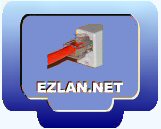|
EZLAN.NET
Copyright © 2001-2007
|
Hardware and Software Specifications, Examples, Links, and other info. are valid at the publishing time. In case it become invalid use the Internet Search. 1st Published, Dec. 2004 Over 6,500,000 Hits Site Wide in 2006 
Sharing Disk Drives Between Computers on Windows Network. It became almost common phenomenon that people set a small Network and are capable of using the Internet from all Network Computers but having Difficulties to Share the Hard drives (and printers) among the Network computers. Being able to Share the Internet connection might indicate that the Hardware works as it should and the General Setting of the Network are set correctly but the Setting of File Sharing and permissions to Share might be Not set, or there might be trouble in the TCP/IP sharing system. If you are Not Sure that your Windows Network system is installed correctly check this page first. Link to: Installing & Sharing Windows Networks. Some Software Firewalls, Live Virus Scanner etc., depending on how they set, would keep working in the background even if you switch them Off. Be aware that some Software Firewalls, Live Virus Scanner etc. would keep working in the background even if you switch them Off. Disable means that if possible do not let the Applications to load at Startup, take them out of the picture until the Network Configuration problems are resolved. Once the problems are solved you can start the Firewall again. However the Software Firewall might block the LAN internal traffic. In order to prevent the Firewall from blocking LAN traffic you have to set the software correctly. Most Software Firewalls have a Settings that allow you to insert a range of Local IPs that should not be blocked (It is usually called Trusted Zone, Intranet or Private Zone, etc.). Insert the IPS range of your computers to the Firewall appropriate Menu. E.g. 198.168.1.1 – 192.168.1.50 such a setting will free from Firewall blocking any local computer with an IP between 198.168.1.1 to 198.168.1.50. If you have trouble in configuring your Network Correctly do not resort to multiple use of the Network Wizard. Configure the Network Settings Manually. Repetitive use of the Windows Network Wizard, as well as installing third party Network's Applications, and Tweak Utilities, might write changes to the Registry without necessarily erasing previous information. As a result, sooner or later, the registry contains conflicting information and Sharing Network Resources through TCP/IP stop working, or can not be configured . Setting the sharing of Windows OS'. Sharing Using WinXP: For the purpose of the initial setting, disable all software Firewall (including WinXP native ICF); disable any active Virus scan or any other utility that might intercept Network Traffic. If you are not concern about internal security WinXP Home and or use Simple sharing. Under Simple Sharing there is no need for user permissions or passwords for LAN interaction. Link to: Windows XP (Home & Pro) Simple File Sharing. WinXP Pro has an additional more secure method: Link to: Windows XP Professional File Sharing. Link to: XP File Sharing Trouble Link to: How to check access to Shared Resources. Link to: Windows XP Access control via Security. Link to: Microsoft Take on Configuring File Sharing in Windows XP
Setting Sharing with Win98 Network. Setting Sharing with Win2000 Network. Link to: Windows 2000 Network Sharing. I checked all my settings and I am sure that every thing is set correctly. However my Computer will Not "Talk" one to the other, What shall I do? If every thing check right it is possible that the TCP/IP Stack is partially "Trashed" (AS an Example, repetitive usage of the Network Wizard might cause this "Trashing"). When this "Trashing" occurs it is quite common that the Internet connection would work correctly, and File Sharing would not. Option 1. Uninstall the Network, reset the TCP/IP Stack, and Reinstall the Network. Link to: How to troubleshoot TCP/IP connectivity with Windows XP. Link to: How to Reset Internet Protocol (TCP/IP) in Windows XP. Option 2. Leave every thing as is. Install NetBEUI, and Bind NetBEUI to File Sharing. Link to: Set NetBEUI as the Default Sharing Protocol in WinXP. Why NetBEUI? NetBEUI is very simple it just uses the computer name does not need the complicated IP system. In contrast, TCP/IP uses the IP system which involves numerous amounts of Registry lines with variety of information. Many Internet/Network applications like Firewalls, Antivirus etc, intercept the traffic through the TCP/IP stack, some of them might interfere with the proper work of TCP/IP resultant with impeding File Sharing. NetBEUI Bypasses all of these, thus allows trouble Free Sharing Once the Sharing works, you can use Windows own Help to learn how to MAP the Network's Hard Drives, Printer, CD-ROM, and Enjoy the Magic. Once the Sharing is Working it can be used to Map the Network's Drives.
Let say that we have one computer name Jack and another computer name
Nick. Mapping a drive (or a folder) makes it much easier to use Network resource since you do not have to look for the resource when it is available like an additional drive on the PC. Important, the sharing must work correctly before you attempt to map a drive. The mapping process does not change the capability to use the mapped devices or an any other share through the Network Nieborhood. How to map? Log to Windows Native Help, enter the term Mapped Drive and it will guide you through the process. Floppy, CD-ROM, ZIP, and USB drives can be similarly be mapped too.
|